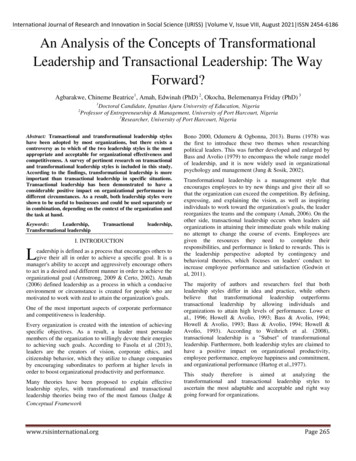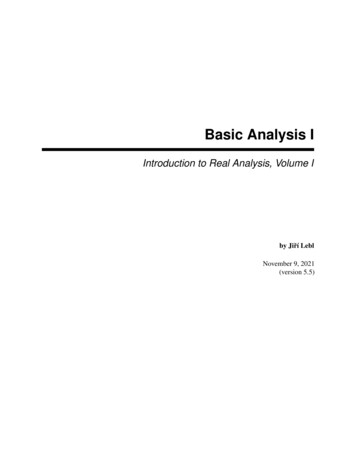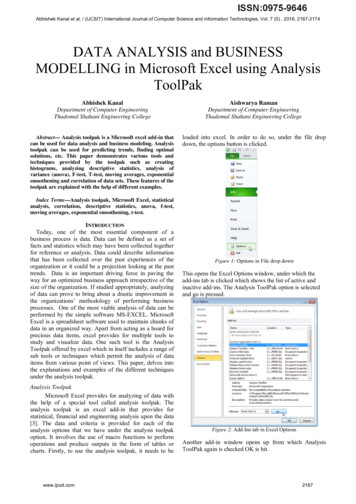
Transcription
International Journal of Research and Innovation in Social Science (IJRISS) Volume V, Issue VIII, August 2021 ISSN 2454-6186An Analysis of the Concepts of TransformationalLeadership and Transactional Leadership: The WayForward?Agbarakwe, Chineme Beatrice1, Amah, Edwinah (PhD) 2, Okocha, Belemenanya Friday (PhD) 31Doctoral Candidate, Ignatius Ajuru University of Education, NigeriaProfessor of Entrepreneurship & Management, University of Port Harcourt, Nigeria3Researcher, University of Port Harcourt, Nigeria2Abstract: Transactional and transformational leadership styleshave been adopted by most organizations, but there exists acontroversy as to which of the two leadership styles is the mostappropriate and acceptable for organizational effectiveness andcompetitiveness. A survey of pertinent research on transactionaland transformational leadership styles is included in this study.According to the findings, transformational leadership is moreimportant than transactional leadership in specific situations.Transactional leadership has been demonstrated to have aconsiderable positive impact on organizational performance indifferent circumstances. As a result, both leadership styles wereshown to be useful to businesses and could be used separately orin combination, depending on the context of the organization andthe task at hand.Keywords:Leadership,Transformational leadershipTransactionalleadership,I. INTRODUCTIONLeadership is defined as a process that encourages others togive their all in order to achieve a specific goal. It is amanager's ability to accept and aggressively encourage othersto act in a desired and different manner in order to achieve theorganizational goal (Armstrong, 2009 & Certo, 2002). Amah(2006) defined leadership as a process in which a conduciveenvironment or circumstance is created for people who aremotivated to work with zeal to attain the organization's goals.One of the most important aspects of corporate performanceand competitiveness is leadership.Every organization is created with the intention of achievingspecific objectives. As a result, a leader must persuademembers of the organization to willingly devote their energiesto achieving such goals. According to Fasola et al (2013),leaders are the creators of vision, corporate ethics, andcitizenship behavior, which they utilize to change companiesby encouraging subordinates to perform at higher levels inorder to boost organizational productivity and performance.Many theories have been proposed to explain effectiveleadership styles, with transformational and transactionalleadership theories being two of the most famous (Judge &Conceptual Frameworkwww.rsisinternational.orgBono 2000, Odumeru & Ogbonna, 2013). Burns (1978) wasthe first to introduce these two themes when researchingpolitical leaders. This was further developed and enlarged byBass and Avolio (1979) to encompass the whole range modelof leadership, and it is now widely used in organizationalpsychology and management (Jung & Sosik, 2002).Transformational leadership is a management style thatencourages employees to try new things and give their all sothat the organization can exceed the competition. By defining,expressing, and explaining the vision, as well as inspiringindividuals to work toward the organization's goals, the leaderreorganizes the teams and the company (Amah, 2006). On theother side, transactional leadership occurs when leaders aidorganizations in attaining their immediate goals while makingno attempt to change the course of events. Employees aregiven the resources they need to complete theirresponsibilities, and performance is linked to rewards. This isthe leadership perspective adopted by contingency andbehavioral theories, which focuses on leaders' conduct toincrease employee performance and satisfaction (Godwin etal, 2011).The majority of authors and researchers feel that bothleadership styles differ in idea and practice, while othersbelieve that transformational leadership outperformstransactional leadership by allowing individuals andorganizations to attain high levels of performance. Lowe etal., 1996; Howell & Avolio, 1993; Bass & Avolio, 1994;Howell & Avolio, 1993; Bass & Avolio, 1994; Howell &Avolio, 1993). According to Weihrich et al. (2008),transactional leadership is a "Subset" of transformationalleadership. Furthermore, both leadership styles are claimed tohave a positive impact on organizational productivity,employee performance, employee happiness and commitment,and organizational performance (Hartog et al.,1977).This study therefore is aimed at analyzing thetransformational and transactional leadership styles toascertain the most adaptable and acceptable and right waygoing forward for organizations.Page 265
International Journal of Research and Innovation in Social Science (IJRISS) Volume V, Issue VIII, August 2021 ISSN 2454-6186Idealized InfluenceTransformational LeadershipInspirational MotivationIntellectual StimulationIndividualized ConsiderationTransactional LeadershipContingent RewardsManagement- By Exception-ActiveManagement-By Exception- Passive.Laissez-FaireII. LTERATURE REVIEWLeadership"A process through which employees in an organization aremotivated, inspired, or encouraged to be productive towardthe achievement of organizational goals," Yukl and Lepsinger(2005) describe leadership. Leadership not only function as aninspirational process, but is particularly involved in creatingthe organizational vision, corporate values and ethics whichare geared towards the organization [Amah, 2006].Effective LeadershipEffective leadership is defined as a leader's capacity to get hissubordinates to perform better over time [McShane, 2009].Effective leadership encourages the adoption and practice oforganizational ethics and good workforce management whichin turn leads to improved performance. As a result of effectiveleadership, subordinates are motivated, committed, and topperformers. Effective leaders focus mainly on the vision,mission and goals of the organization and insist on theworkers doing the right things, while managers are concernedabout doing things right. They promote change and challengesituations as they arise (Bennis, 1989).The impactful efforts of successful managers (leaders) onworkers improve organizational performance. Example ofsuch leaders was Gordon Bethune who transformedContinental Airline that went bankrupt in 1994, restored it to anumber one on-time airline of that decade. Louis Gerstnerwww.rsisinternational.orgalso transformed IBM company from a money-losingcomputer hardware company to a powerful servicing firm(McShane, 2008). As previously stated, good leaders improveorganizational performance, and bad leaders reduceperformance. Continental Airlines, for example, had gonethrough 10 CEOs in as many years and was looking for agood leader until Gordon Bethune came along and made asubstantial contribution to the airline's success. Bad leaders,on the other hand, have a tendency to drain the "economicvalue" of the firm. AI Dunlop, popularly known as "ChainsawAI," was a tough boss who took a hard line to cut expenses,causing Sunbeam to go bankrupt in less than two years,exhibiting bad leadership (McShane, 2009).Researchers have attempted to discover successful leadershipstyles that can contribute to positive organizational resultsover the years. Two of the leadership perspectives that will bediscussed in this study are transformational and transactionalleadership styles.Transformational LeadershipTransformational leadership is defined as "leaders' behaviorsthat transform and drive followers to achieve beyondexpectations while transcending self-interest for the sake ofthe company" (Avolio et al., 2009). Transformational leadersare noted for re-energizing and leading ailing businesses innew directions by changing operational processes,organizational design, and culture (Bass, 1990). In addition, atransformational leader, according to Zaleznik (1977),Page 266
International Journal of Research and Innovation in Social Science (IJRISS) Volume V, Issue VIII, August 2021 ISSN 2454-6186concentrates on changing the organizational context, changingtactics, and changing culture to meet the operatingenvironment. In today's world of technological advancementsand developments, many businesses face fierce competitionfrom competitors in order to get a larger market share and acompetitive advantage over their competitors. To survive insuch a challenging situation, organizations require exceptionalleaders who can re-strategize the organizational structure andactivities. Louis Gerstner was an example of atransformational leader who re-engineered and repositionedIBM, which had lost billions of dollars in 1991 whiledomineering the market with mainframe computers, into anone-to-equal; whereas new organizations such as DellComputers, Microsoft, and Intel made a technological shift topersonal computers, which drew large crowds (McShane,2009). Heinrich Von PIERER, a CEO of a German CompanySiemens in the 1990s, transformed the enterprise that sufferedstiff competition globally due to their organizational culturethat was conservative and perfectionist and so did not allowinnovation and creativity. But as Von Pierer became CEO in1992, he created an atmosphere that encouragedsubordinates‟interaction, critique, training and innovationwhich gained the organization a competitive advantage(Evans, 1970).According to Schuster (1994), transformational leadershipaims to increase employee engagement while also improvingtheir quality of life. Transformational leaders, according toFasolaet al (2013), have empathy for their subordinates'developmental needs, which motivates them to act on theirown needs as well as the needs of others and the group as awhole. Employees who work for transformative leaders aremore civic-minded and take part in workplace decisionmaking (Barling et al, 1996). The following transformationalleadership outcomes on subordinates were identified byPounder (2008): a) the leader's ability to motivatesubordinates to work hard, b) the subordinates' understandingand belief in the leader's efficacy, and c) the subordinates'contentment with the leader. Dixon (1998) identified fourprimary intrinsic characteristics that influence a leader'sbehavior, including self-confidence, integrity, honesty, andpersonal ideals, based on his research. Burns outlines fourmajor characteristics of transformational leadership: idealizedinfluence, inspiring drive, intellectual stimulation, andcustomized concern (1978).1) Idealized Influence: This refers to how much thesubordinates admire the leader's actions, whichcauses them to identify with him.2) Inspirational Motivation: This metric reflects howmuch the leader's stated vision appeals to andmotivates followers to be optimistic about futuregoals while remaining focused on the current work.3) Intellectual Stimulation:This demonstrates theleader's ability to question assumptions, take risks,and get feedback from subordinates.4) Individualized Consideration: This demonstrates howconcerned the boss is about each subordinate's well-www.rsisinternational.orgbeing and how he behaves as a mentor or coach tohim.Transformational leadership happens when leaders impacttheir employees in three ways, according to Jones & George(2006):1) Transformational leaders teach their people the valueof their work and the importance of giving it their allto achieve the organization's goals.2) Transformational leaders make it apparent to theirsubordinates that they must grow, develop, andsucceed in their jobs.3) Transformational leaders inspire their employees towork hard not just for their own personal benefit, butfor the sake of the company as a whole.Elements of Transformational LeadershipAccording to McShane (2009), transformational leadershipconsists of seven elements:1) NEW VISION: To begin with, transformationalleaders, as previously said in this work, have a newvision for the organization that involves changes inculture, strategy, and organizational design, as wellas the adoption of new norms and values. Accordingto Jones & George (2006), transformationalmanagers are charismatic in their behavior and havea vision of how things should be done in teams andin the company that is considerably different fromthe norm. Such a vision allows for significant gainsin group and organizational performance (Jones &George, 2006).2) COMMUNICATEVISION:Transformationalleaders constantly convey their new vision tosubordinates through simple and unambiguousphrases, images, and symbols in order to persuadethem to accept it and educate them on how to carry itout (Conger, 1991).3) MODEL DESIRED BEHAVIOR: Transformationalleaders set an example by living by the ideals theypreach in order to attain their goals. This was astrategy used by Lee Iacocca, when he took over asCEO of Chrisyler Company which was at the vergeof going bankrupt. In the struggle for the company'ssurvival, his decision to take a one-dollar-a-yearsalary pending the company's return to profitabilitysent a message of togetherness to the employees(McShane, 2009).4) EMPOWEREMPLOYEES:Transformationalleaders empower their subordinates in a number ofways to carry out the new vision's initiatives. Forexample, in his appeal to subordinates to help andenhance Continental Airlines, Gordon Bethuneoffered them a part of the company's profits.5) MEANINGFUL CHANGES: To gain gnificant and significant changes in thePage 267
International Journal of Research and Innovation in Social Science (IJRISS) Volume V, Issue VIII, August 2021 ISSN 2454-6186organization's activities, control, incentive systems,and architecture. Continental Airline's CEO achievedthis by tying employee bonuses to improvedcustomer service.6) LEAD WITH INTEGRITY: Transformationalleaders have a high reputation for being dependable,honest, and fair, but they are firm in their decisions.They conduct business in an ethical, transparent, andhonest manner.7) CREATE AN ENDURING ORGANIZATION:Transformational leaders build and manageorganizations that will continue to functionsuccessfully and efficiently long after they have leftthe company. Transformational leaders who are greatbuild strong organizations consolidate it and developemployees who will continue after they are gone.Transactional LeadershipEmployees are driven by a "exchange of rewards,compliments, and incentives," according to transactionalleadership (Fasola et al., 2013). Bass (2008), noted thattransactional leaders lead by means of „social exchange‟.Transactional leadership, according to Ivey and Kline (2010),involves characteristics of 'leader-follower exchanges,' inwhich leaders exchange valuable products with subordinatesin the interest of each other's 'agenda.' Furthermore,transactional leaders, according to Scareset al (1992) andArmstrong (2009), "sell money, jobs, and security forsubordinates to follow directions." In other words, usingrewards and power-influence to motivate high-performingsubordinates, reinforce desired behaviors, and reprimand andpenalize low-performing subordinates.Transactional leadership, often known as managementleadership, is responsible for supervisory, organizational, andgroup performance. According to Odumeru and Ifeanyi(2013), transactional leadership is a subset of transformationalleadership, and both are linked to organizational success. Thistype of leadership is most effective in times of crisis andemergency, as well as when projects must be performedprecisely and meticulously. Transactional leaders, accordingto Hargris et al. (2010), are more concerned with monitoringsubordinates' work efforts and procedures, as well asdeviations, than with thinking about the future. This is toimply that transactional leaders lead in an action-orientedmanner. They put a greater emphasis on lower-level needs byfocusing on individual task performance. Transactionalleaders, according to Durbrin (2004), should concentrate onclarifying duties and tasks, which he agrees with.Bass & Avolio (1994), noted that transactional leadership hasfour components:1) CONTINGENT REWARD: Odumeru & Ifeanyi (2013),pointed out two types of contingent reward:Contingent positive reinforcement and reinforcement in the form of praise or reward is deliveredwww.rsisinternational.orgwhen certain goals are fulfilled on time or ahead ofschedule. Contingent negative reinforcement is employedwhen set goals are not met, tasks are not finished, orperformance is poor. According to Fasola et al (2013),dependent rewards are given to the subordinates groupbased on the achievement of defined goals on time, aheadof schedule, or promoting good working speed to jobcompletion. They further noted that group punishmentsare meted on the group like suspension, salary cuts orextension of work hours where assigned goals or tasks arenot achieved or production quality or quantity fell belowstandard.2) MANAGEMENT-BY-EXCEPTIONACTIVE:Management by exception occurs in transactionalleadership when the leader intervenes when there aredeviations from the rules and regulations, anticipatesproblems or stated performance levels are not met, andinitiates measures to correct and resolve the problems toimprove subordinate performance, according to Hackman(2009).3) MANAGEMENT-BY-EXCEPTION –PASSIVE:Leaders who manage by exception – passively, accordingto Odumeru and Ifeanyi (2013), do not become involvedin resolving problems; instead, they stand by until theproblems become too serious, at which point they act.4) LAISSEZ - FAIRE: According to Robbin & Coulter(2007), leaders avoid making judgments and takingresponsibility in this strategy. Instead, leaders delegatetotal responsibility, freedom, and influence over workdecisions to subordinates (Chaudhry & Javed, 2012).Transactional leadership, according to Khalil et al., (2016),comprises an exchange process in which followers obtainimmediate and tangible rewards for obeying the leaders'directions. Rewards and incentives have a critical role inemployee engagement in transactional leadership, accordingto Burns (1978), as cited by Khalil et al., (2016). According toJohnson (2017), transactional leadership managers provideassignments to employees and reward or punish teammembers based on performance. Transactional leadership,according to Ingram (2019), can be defined as "arrow hit thetarget" since leaders are more concerned with tasks beingcompleted easily and on time rather than traditionalorganizational tactics.Instead of imagining an exciting and challenging future,transactional leaders frequently maintain the status quo andcontrol their employees. Because transactional leadership isbased on risk aversion and protecting the status quo, it isthought to be anti-entrepreneurial because it discouragesemployees from seeking out and exploiting chances.Followers of this leadership style tend to limit themselves tofollowing the leaders' orders and doing exactly what they'vebeen taught (Moses & Ritossa, 2007; Ryan & Tipu, 2013).According to Jung (2001), transactional leaders are primarilyconcerned with operational effectiveness and processefficiency within the limits of existing systems. SubordinatesPage 268
International Journal of Research and Innovation in Social Science (IJRISS) Volume V, Issue VIII, August 2021 ISSN 2454-6186only try to meet the agreed-upon level of performance forwhich they will be rewarded or punished in such rmational LeadershipTransactionalandJames Macgregor Burns distinguished between transactionaland transformative leadership styles, according to Odumeru &Ogbonna (2013). Northouse (2016), UK Essay (2017), Ronald(1998), Joseph (2015), and Surbhi (2015), among others,found notable disparities between the two leadership stylesunder consideration as follows:Transactional Leadership and Transformational LeadershipTRANSACTIONALLEADERSHIPLeaders reward exchange for workand Leaders engage subordinatesand focus on subordinates‟ loyaltyhigher level intrinsic needs.12Operates within existing culture ofthe organization3Subordinates are motivated byconsideringtheir personal interest first.4Objectives are achieved by andideals.Leaders employ management-by exception to correct, monitor andimprove subordinateperformance.Transactional leaders react quicklyand in a positive way to issues.Leadership is best for a stablesettingTransactional leadership isbureaucratic.56789Focus is on planning and execution10Gives room for only one leader in agroup11Emphasis is placed on leaders withfollowers.12Subordinates work under strict rulesand regulations presentingrigidity of work.TRANSFORMATIONALLEADERSHIPOperates to change the cultureof theorganization with new visionand ideas.Subordinates are encouraged toattend togroup interest first.Objectives are achieved by highmoralvalues subordinates throughIndividuals are allowed to makepersonal inputs.Strong positiverelationship withorganizationalperformance.Weak Positiverelationshipwith organizationalperformance.Limitations and Weaknesses of Transformational andTransactional Leadership StylesTransactional LeadershipAccording to Galilee (2018), transactional leadershipsubordinates are unable to express their inventiveness becauseto their superiors' required tight adherence to rules andregulations. Afsar et al (2016), noted that subordinates mightalso consider this leadership style as rigid, inflexible,bureaucratic, centralized and less empowering scenario,thereby inhibiting entrepreneurial behavior.The „broad thinking approach‟ that presents abrupt rules andsupervision may produce followers instead of leaders oftomorrow. Risk taking is minimized under transactionalleadership, which may compromise lucrative gain.There is no emotional attachment to subordinates aspunishments, salary cuts, denial of promotions or terminationfrom the team could be meted on those with undesired results.Transformational LeadershipAccording to Bently (2002), transformational leaders have atendency to utilize their manipulative influence in unethicaland self-centered ways, which can have a negative impact onthe organization.Leaders handles mattersproactively.Leadership is good for troubledsetting.Transformational leaders' difficult duties, as well as extendedhours of labor or overtime, may have an impact onsubordinates' performance, resulting in low productivity(Natalie, 2014).Leadership is charismatic.III. EMPIRICAL REVIEWFocuses on promotinginnovation.There can be more than oneleader in a groupEmphasis laid on values, beliefsand needs of the leader andfollowers.Despite its many critics, transformational leadership hasgained appeal in recent years. According to studies ofmanagers in a variety of situations, including the military,corporations, and management, transformational leadership ismore effective, with higher subordinate performance, morepromotion, and more sensitive interpersonal interactions thantransactional leadership. According to other research,transformative leadership is strongly associated to employeeoutcomes like reduced turnover, increased productivity,employee happiness, innovation, goal achievement, andemployee well-being (Judge & Bono, 2000, Piccolo &Colquitt, 2006, EisenbeiB & Boerner, 2013, Garcia-Moraleset al, 2008, Keller,1992).Subordinates work creativelyand efficiently.Appraisal of Transformational and Transactional LeadershipEffect in Different ONALSmall Firms (Chile)Positive impactNegative ImpactBankNot impactfulEffectiveSmall scaleenterprise(Nigeria) positiveimpact.Insignificant effect.Significant morePrivate schoolsperformance.Less related toemployeeemployeeperformance.More positively related to(Pakistan).www.rsisinternational.orgWater Company(Nigeria)According to other research, transformative leadership isstrongly associated to employee outcomes like reducedturnover, increased productivity, employee happiness,innovation, goal achievement, and employee well-being(Judge & Bono, 2000, Piccolo & Colquitt, 2006, EisenbeiB &Boerner, 2013, Garcia-Morales et al, 2008, Keller,1992). Inother research, transactional leadership was found to have aconsiderable favorable impact on performance, whilePage 269
International Journal of Research and Innovation in Social Science (IJRISS) Volume V, Issue VIII, August 2021 ISSN 2454-6186transformational leadership had a minor but positive impact.(Obiwuru and colleagues, 2011).In the United States, Muterara (2012) discovered that bothtransformational and transactional leadership styles werepositively connected with organizational performance, withtransformational leadership having a bigger influence thantransactional leadership. Ejere and Abasilim's findings backup those of Prodeep and Prabhn (2011) and Muterara (2012),who found that transformational leadership had a strongerimpact on organizational performance than transactionalleadership. The findings contrast those of Paracha et al.,(2012), who reported a stronger correlation betweentransactional and transformational leadership styles andorganizational performance.According to Ojukwu et al., (2012), transformationalleadership was positively connected to bank workerperformance, whereas transactional leadership was negativelyrelated. In a study of the leadership behavior of presidents atvarious institutions, Weber (2003) discovered a significantpositive relationship between transformational leadership andwork satisfaction and motivation of subordinates. Accordingto Howell and Avolio (1993), the usage of contingentcompensation has a negative influence on employeeperformance. Transactional leadership, according to Bass(2008), has a negative impact on subordinates' worksatisfaction and performance.Several studies, however, have discovered that bothtransformational and transactional leadership styles have animpact on employee motivation (Abdul et al., 2012, & Judge& Piccolo, 2004). In Pakistan, for example, Abdul et al.(2012) investigated the impact of transformational andtransactional leadership styles on employee motivation. Bothleadership styles were found to have a substantial positive linkto organizational commitment (Barbuto, 2005; Ibrahim, 2010;Charles & Catherine, 2007). On the other hand, Fasola et al.(2013) discovered that while there was a positive relationshipbetween transformational leadership and bank staffcommitment, it was not very significant, implying that thestyle adopted did not exactly induce their commitment.Transactional leadership style was proven to be more effectivethan transformational leadership style in influencing people.According to Joseph (2015), transformational leadership wasfavoured by 86.7 percent of respondents, whereastransactional leadership was valued by just 53 percent.Kalsoom et al. (2018) did their own research on a Pakistanisector, finding that transactional leadership had a rmational leadership. Transformational leadership,according to Nsom et al., (2019), has a considerable positiveimpact on employee behavior, whereas transactionalleadership has a negative impact.According to Brymer and Gray (2006), the transformationalleadership paradigm is more appropriate for effective outdoorleadership, but that in some circumstances, recognition andwww.rsisinternational.orgcompensation for specific tasks accomplished by staff may benecessary. Employee performance was favorably connectedwith transformational leadership, according to Li and Hung(2009) in their study of 570 school teachers. In another studyconducted in India, Biswas (2009) discovered thattransformative leadership has a positive impact and is stronglylinked to employee performance. Transformational leadership,according to Asfar et al., (2016), is more beneficial,advantageous, and effective than transactional leadership inencouraging entrepreneurial behavior, but only whenemployees have a greater psychological empowermentattitude and belief.IV. GAP IN LITERATUREIn both transformational and transactional leadership, there isa vacuum in the literature on the traits that negatively affectorganizational success. Second, there aren't enough empiricalresearch and evidence on the impact of transformational andtransactional leadership styles in various and similar firms tomake meaningful comparisons and generalizations based ontheir findings.V. FINDINGS OF THE STUDYAccording to the findings of this study, different authors andacademics have differing opinions about which of the twoleadership styles, transformational and transactional, is mostsuited to enterprises. According to the study, both leadershipstyles have a positive relationship and impact onorganizational performance. However, the study found that insome situations, transformational leadership was moreimportant than transactional leadership. In other cases,transactional leadership had a significant positive impact onorganizational performance, whereas transformationalleadership, despite being positively correlated, had a minorimpact. This was also the opinion of Pawar and Eastman(1997), who stated that transformational leadership may beappropriate in some settings but not in others. For instance,organizations in troubled state, need change and improvementin their performance. For companies in a stable performanceposition, transactional leadership may be more suited.VI. CONCLUSIONBecause the findings of this study demonstrated thattransformational and transactional leadership styles have goodbenefits in varied contexts, they cannot be applied to everyorganization. Rather, they've presented confirmation of thelink between transformational and transactional leadershipand organizational success.As a result, both transformational and transactional leadershipstyles are found to be beneficial to organizations, and they canbe utilized independently or in combination, depending on t
Elements of Transformational Leadership According to McShane (2009), transformational leadership consists of seven elements: 1) NEW VISION: To begin with, transformational leaders, as previously said in this work, have a new vision for the organization that involves changes in culture, strategy, and organizational design, as well











